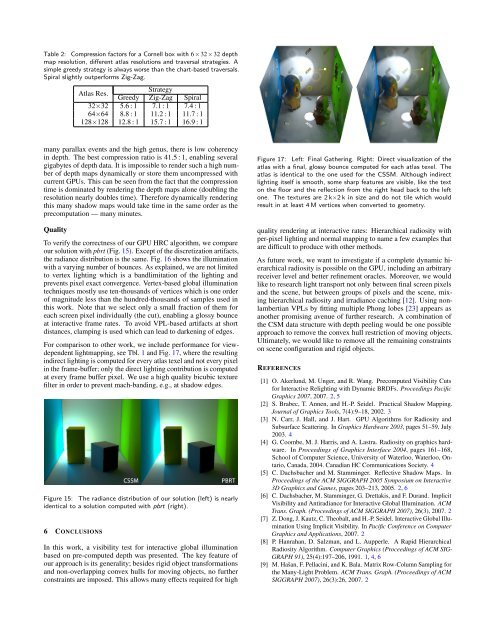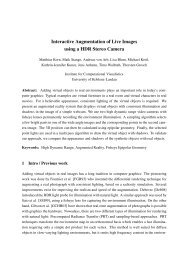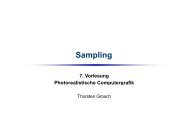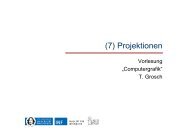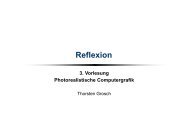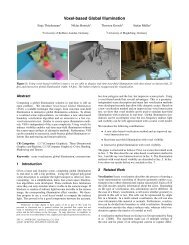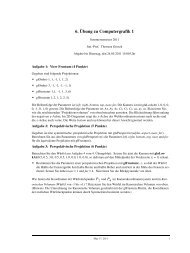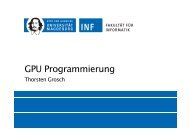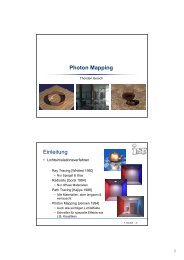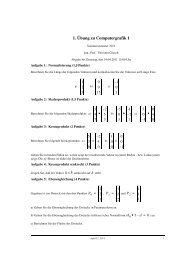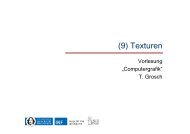Interactive Global Illumination Based on Coherent Surface Shadow ...
Interactive Global Illumination Based on Coherent Surface Shadow ...
Interactive Global Illumination Based on Coherent Surface Shadow ...
You also want an ePaper? Increase the reach of your titles
YUMPU automatically turns print PDFs into web optimized ePapers that Google loves.
Table 2: Compressi<strong>on</strong> factors for a Cornell box with 6×32×32 depth<br />
map resoluti<strong>on</strong>, different atlas resoluti<strong>on</strong>s and traversal strategies. A<br />
simple greedy strategy is always worse than the chart-based traversals.<br />
Spiral slightly outperforms Zig-Zag.<br />
Atlas Res.<br />
Strategy<br />
Greedy Zig-Zag Spiral<br />
32×32 5.6 : 1 7.1 : 1 7.4 : 1<br />
64×64 8.8 : 1 11.2 : 1 11.7 : 1<br />
128×128 12.8 : 1 15.7 : 1 16.9 : 1<br />
many parallax events and the high genus, there is low coherency<br />
in depth. The best compressi<strong>on</strong> ratio is 41.5 : 1, enabling several<br />
gigabytes of depth data. It is impossible to render such a high number<br />
of depth maps dynamically or store them uncompressed with<br />
current GPUs. This can be seen from the fact that the compressi<strong>on</strong><br />
time is dominated by rendering the depth maps al<strong>on</strong>e (doubling the<br />
resoluti<strong>on</strong> nearly doubles time). Therefore dynamically rendering<br />
this many shadow maps would take time in the same order as the<br />
precomputati<strong>on</strong> — many minutes.<br />
Quality<br />
To verify the correctness of our GPU HRC algorithm, we compare<br />
our soluti<strong>on</strong> with pbrt (Fig. 15). Except of the discretizati<strong>on</strong> artifacts,<br />
the radiance distributi<strong>on</strong> is the same. Fig. 16 shows the illuminati<strong>on</strong><br />
with a varying number of bounces. As explained, we are not limited<br />
to vertex lighting which is a bandlimitati<strong>on</strong> of the lighting and<br />
prevents pixel exact c<strong>on</strong>vergence. Vertex-based global illuminati<strong>on</strong><br />
techniques mostly use ten-thousands of vertices which is <strong>on</strong>e order<br />
of magnitude less than the hundred-thousands of samples used in<br />
this work. Note that we select <strong>on</strong>ly a small fracti<strong>on</strong> of them for<br />
each screen pixel individually (the cut), enabling a glossy bounce<br />
at interactive frame rates. To avoid VPL-based artifacts at short<br />
distances, clamping is used which can lead to darkening of edges.<br />
For comparis<strong>on</strong> to other work, we include performance for viewdependent<br />
lightmapping, see Tbl. 1 and Fig. 17, where the resulting<br />
indirect lighting is computed for every atlas texel and not every pixel<br />
in the frame-buffer; <strong>on</strong>ly the direct lighting c<strong>on</strong>tributi<strong>on</strong> is computed<br />
at every frame buffer pixel. We use a high quality bicubic texture<br />
filter in order to prevent mach-banding, e.g., at shadow edges.<br />
Figure 15: The radiance distributi<strong>on</strong> of our soluti<strong>on</strong> (left) is nearly<br />
identical to a soluti<strong>on</strong> computed with pbrt (right).<br />
6 CONCLUSIONS<br />
In this work, a visibility test for interactive global illuminati<strong>on</strong><br />
based <strong>on</strong> pre-computed depth was presented. The key feature of<br />
our approach is its generality; besides rigid object transformati<strong>on</strong>s<br />
and n<strong>on</strong>-overlapping c<strong>on</strong>vex hulls for moving objects, no further<br />
c<strong>on</strong>straints are imposed. This allows many effects required for high<br />
Figure 17: Left: Final Gathering. Right: Direct visualizati<strong>on</strong> of the<br />
atlas with a final, glossy bounce computed for each atlas texel. The<br />
atlas is identical to the <strong>on</strong>e used for the CSSM. Although indirect<br />
lighting itself is smooth, some sharp features are visible, like the text<br />
<strong>on</strong> the floor and the reflecti<strong>on</strong> from the right head back to the left<br />
<strong>on</strong>e. The textures are 2 k×2 k in size and do not tile which would<br />
result in at least 4 M vertices when c<strong>on</strong>verted to geometry.<br />
quality rendering at interactive rates: Hierarchical radiosity with<br />
per-pixel lighting and normal mapping to name a few examples that<br />
are difficult to produce with other methods.<br />
As future work, we want to investigate if a complete dynamic hierarchical<br />
radiosity is possible <strong>on</strong> the GPU, including an arbitrary<br />
receiver level and better refinement oracles. Moreover, we would<br />
like to research light transport not <strong>on</strong>ly between final screen pixels<br />
and the scene, but between groups of pixels and the scene, mixing<br />
hierarchical radiosity and irradiance caching [12]. Using n<strong>on</strong>lambertian<br />
VPLs by fitting multiple Ph<strong>on</strong>g lobes [23] appears as<br />
another promising avenue of further research. A combinati<strong>on</strong> of<br />
the CSM data structure with depth peeling would be <strong>on</strong>e possible<br />
approach to remove the c<strong>on</strong>vex hull restricti<strong>on</strong> of moving objects.<br />
Ultimately, we would like to remove all the remaining c<strong>on</strong>straints<br />
<strong>on</strong> scene c<strong>on</strong>figurati<strong>on</strong> and rigid objects.<br />
REFERENCES<br />
[1] O. Akerlund, M. Unger, and R. Wang. Precomputed Visibility Cuts<br />
for <str<strong>on</strong>g>Interactive</str<strong>on</strong>g> Relighting with Dynamic BRDFs. Proceedings Pacific<br />
Graphics 2007, 2007. 2, 5<br />
[2] S. Brabec, T. Annen, and H.-P. Seidel. Practical <strong>Shadow</strong> Mapping.<br />
Journal of Graphics Tools, 7(4):9–18, 2002. 3<br />
[3] N. Carr, J. Hall, and J. Hart. GPU Algorithms for Radiosity and<br />
Subsurface Scattering. In Graphics Hardware 2003, pages 51–59, July<br />
2003. 4<br />
[4] G. Coombe, M. J. Harris, and A. Lastra. Radiosity <strong>on</strong> graphics hardware.<br />
In Proceedings of Graphics Interface 2004, pages 161–168,<br />
School of Computer Science, University of Waterloo, Waterloo, Ontario,<br />
Canada, 2004. Canadian HC Communicati<strong>on</strong>s Society. 4<br />
[5] C. Dachsbacher and M. Stamminger. Reflective <strong>Shadow</strong> Maps. In<br />
Proceedings of the ACM SIGGRAPH 2005 Symposium <strong>on</strong> <str<strong>on</strong>g>Interactive</str<strong>on</strong>g><br />
3D Graphics and Games, pages 203–213, 2005. 2, 6<br />
[6] C. Dachsbacher, M. Stamminger, G. Drettakis, and F. Durand. Implicit<br />
Visibility and Antiradiance for <str<strong>on</strong>g>Interactive</str<strong>on</strong>g> <str<strong>on</strong>g>Global</str<strong>on</strong>g> <str<strong>on</strong>g>Illuminati<strong>on</strong></str<strong>on</strong>g>. ACM<br />
Trans. Graph. (Proceedings of ACM SIGGRAPH 2007), 26(3), 2007. 2<br />
[7] Z. D<strong>on</strong>g, J. Kautz, C. Theobalt, and H.-P. Seidel. <str<strong>on</strong>g>Interactive</str<strong>on</strong>g> <str<strong>on</strong>g>Global</str<strong>on</strong>g> <str<strong>on</strong>g>Illuminati<strong>on</strong></str<strong>on</strong>g><br />
Using Implicit Visibility. In Pacific C<strong>on</strong>ference <strong>on</strong> Computer<br />
Graphics and Applicati<strong>on</strong>s, 2007. 2<br />
[8] P. Hanrahan, D. Salzman, and L. Aupperle. A Rapid Hierarchical<br />
Radiosity Algorithm. Computer Graphics (Proceedings of ACM SIG-<br />
GRAPH 91), 25(4):197–206, 1991. 1, 4, 6<br />
[9] M. Hašan, F. Pellacini, and K. Bala. Matrix Row-Column Sampling for<br />
the Many-Light Problem. ACM Trans. Graph. (Proceedings of ACM<br />
SIGGRAPH 2007), 26(3):26, 2007. 2


